Trending
Opinion: How will Project 2025 impact game developers?
The Heritage Foundation's manifesto for the possible next administration could do great harm to many, including large portions of the game development community.

Featured Blog | This community-written post highlights the best of what the game industry has to offer. Read more like it on the Game Developer Blogs or learn how to Submit Your Own Blog Post
In April, the Museum of Art and Digital Entertainment commissioned a Minecraft recreation of downtown Oakland, California. The results were exhibited to the public at the Oakland Museum of California, where visitors then interacted with the Oakland map.

On April 27, The Museum of Art and Digital Entertainment, in collaboration with the Oakland Museum of California's We Customize exhibit, the Paradise Minecraft Server community, and Mojang, displayed a Minecraft recreation of Oakland, California. The exhibit was interactive, with an on-site server and multiple computers logged in together.
For the impatient, you can download the Oakland map, plus the results of each day the map was opened to the public at the museum here.
This exhibit took place over 3 days at the OMCA.
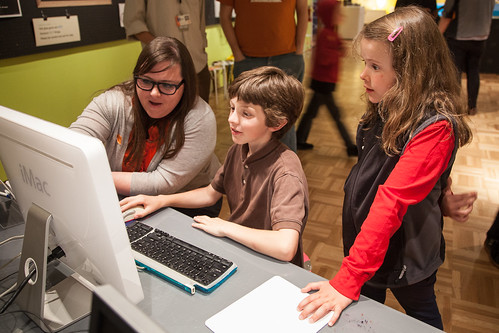
Oddly, after years of working with Gamasutra and the soon-to-be-defunct Game Developer Magazine, I have never had call to write a Post Mortem. I've edited a few, read hundreds, but never written one!
I really feel as though this project was a perfect model for how communities and institutions can collaborate to bring interesting new interactive experiences to the public. In the future, I would hope more opportunities like this arrise, where an client/server style presentation can be used to bring collaboration between museum visitors and the art itself.
Who's Who
The Museum of Art and Digital Entertainment is a 501c3 non-profit videogame museum located in downtown Oakland. It hosts community events, playable exhibits of significant works, and free programming classes for kids every week.
The Oakland Museum of California is an art and history museum in downtown Oakland. Open for over 40 years, this museum features an unique architectural design that incorporates trees and landscaping into its structure. The We Customize exhibit was open from February 9 through June 2 of this year.
The Paradise Minecraft Server was discovered via Reddit. A few weeks before the exhibit opened on April 27, I posted this to /r/minecraft. The response was phenomonal, and I chose HuskerGirlKC as the winning bidder for the job of building Oakland. Turns out, she ran a server and had hordes of 12-year-olds just waiting to build anything she asked for. HuskerGirlKC turned out to be an incredible project leader, also.
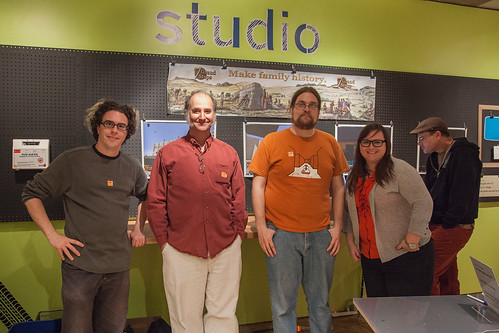
As an adjunct onto the exhibit, I invited two local independent game developers to show their wares over the weekend, as well.
James Crawford was invited to demonstrate Frog Fractions, the most amzingly deep game you've ever played involving frogs and scientific notation. James' work shows incredible creativity and humor hidden beneath a seemingly banal veneer.
Keith Nemitz was on-hand to demonstrate his upcoming release, Seven Grand Steps. His work demonstrates the incredible power of storytelling in games. Seven Grand Steps charts the lives of generations as players strategically pick their way through ancient history.

The Start
This all began back October of 2012, when I met Sean Olsen, from the Oakland Museum of California, while setting up for the East Bay Mini Maker Faire. We were waiting in the driveway of the Park Day School and discussing our respective exhibits for the weekend's event. Sean's exhibit, We Customize, was focused on showing off the work of locals who had transformed everyday items, such as bikes, toys and musical insturments.
To this end, the OMCA offered East Bay Mini Maker Faire attendees a workstation where they could cut apart action figures and toys, and glue them back together into customized toy monstrosities. The results were displayed in the We Customize gallery, and they were quite breathtaking. There were hundreds of them.

Sean and I talked, and agreed to regroup in March to chat about a potential collaboration in the We Customize space. I, foolishly, forgot to tell anyone at the MADE about this, and as a result, when we sat down again in March, I was unprepared for an exhibit.
Not completely, unprepared, however. We had batted around a few ideas, prior to reconvening. My first thought was to look at game mods, like Team Fortress 2. Showing the Quake mod, the Half-Life 1 mod, and the Half-Life 2 mod/standalone game, I thought, would be a great way to show how players had customized a game they liked, and then gone pro with it.
But this was also a very violent option, and this was an exhibit where kids would coming through. Alternately, I had thought about Minecraft, at the time of our initial discussion, but that was about as far as I'd gotten.
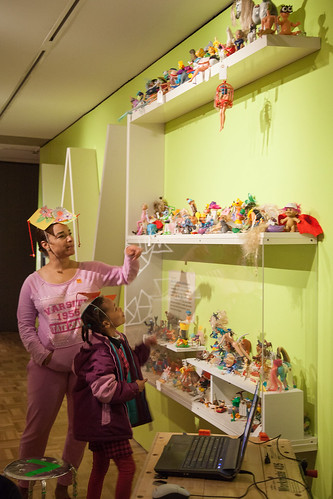
Fast forward to March, and I'm meeting with Sean again, and completely without a plan. I even started to consider who else I could get to fill the gallery for the weekend of April 27, a spot they'd set aside specifically after Sean and I had batted the date around via email.
In desperation, I suggested we could find some people to build us a Minecraft map. It was a long shot, but I told Sean to hang tight, while I looked into putting together the resources for such an exhibit. If nothing else, we could do a server and a couple clients, all manipulating the same map at once.
At this time, in March, the MADE had only just become a stable operation, thanks to a generous donation from Will and Anya Wright. With their help, we were finally able to begin thinking about something other than "OMG can we pay next month's rent?" As such, we had only just begun to seriously look for computers to replace those in our classroom.
Fortunately, not a week after I spoke to Sean and the OMCA, Daniel James of ThreeRings and Sega contacted me to offer a parcel of old computers from his studio. Old computers to him were exceptionally powerful new rigs to us. Our kids classroom, up to this point, had even included a PC with a 5.25" floppy drive in it. We were delighted to pick up a bunch of dual core machines from ThreeRings.
And because these machines were up to snuff, we actually had the resources to bring a few to the OMCA for the Minecraft exhibit. We'd needed at least one server and 6 clients, or at least 5 clients and a server doing double duty. The ThreeRings donation came at just the right time for that.
Perhaps even more astounding, when I went to pick those computers up in downtown San Francisco, there was a parking space right in front of the door. Truly, the stars were aligning.
Next step in the process was to contact Jens Bergensten, AKA jeb, the fellow at Mojang now tasked with directing Minecraft. I emailed Jens asking for a few Minecraft licenses for the museum, and he quickly replied with enough for all the machines we needed.
The final step was to find someone, or a group of someones to build Oakland! I'll leave that for the 5 and 5 section below.
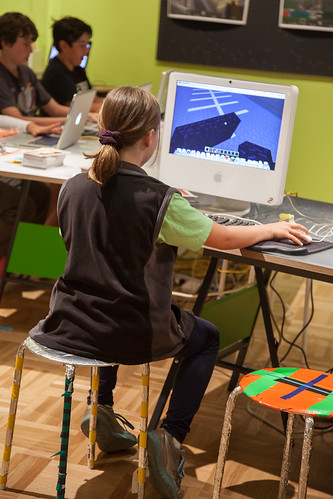
What Went Right
1: Reddit Comes Through
The MADE had previously tangled with Reddit, and the experience left a bad taste in our mouths. When we began this journey into building a videogame museum, we reached out to Reddit and the local Redditor community, seeking support and volunteers. Folks largely ignored us at first.
But then, someone came into the absolutely dead threads we'd start and claim we were a scam. Lo and behold, whoever this guy was, the Redditors believed him and not us, and our largely ignored threads began turning into witch hunt threads where everyone would shout for our heads, without any proof we weren't what we said we were.
Under the advice of the MADE's amazing volunteers, I tried to target only specific sub-Reddits from then on. Sub-Reddits, it seemed, can foster more restrained and intelligent communities.
Turns out, they were absolutely right. When I posted a call for Minecraft builders in /r/minecraft, I had dozens of friendly volunteers coming forward. HuskerGirlKC and her accomplice, HIDDENW0RM, won the bidding process by showing off the Palace of Verssaille they'd built. You really couldn't argue with their craftspersonship.
So, while Reddit-proper remains a horrible place, more dangerous than useful, the sub-Reddits can be a great place to engage with a community.
2: Time Constraints
When all was said and done, and all the pieces were in place, we still only had 10 days to build Oakland. And this is where HuskerGirlKC shined. She herded her hordes of players, most of whom were born after the turn of the millennium, into building a place they'd never heard of, never been to, and likely weren't old enough to travel to, anyway.
I was certain that 10 days wouldn't be enough time to build much of Oakland, but after watching HuskerGirlKC literally conjur 1111 Broadway out of thin air on the first evening after they'd laid out the streets, I wasn't worried anymore.
HuskerGirlKC, in fact, said that the time constraints made it fun. Even more interesting, she and her Danish cohort, HIDDENW0RM, had already considered building the Oakland Museum of California before I'd come along. They'd been looking for an interesting project to take on, and the OMCA has an unique architecture.
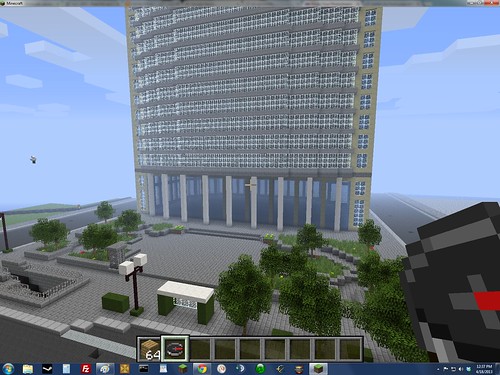
3: Real Museum Resources
The Oakland Museum of California is a real museum. They've been around for over 40 years. They've got storage space, multiple giant galleries with permanent exhibits. They host weekly parties with food trucks and music and booze. They've got a functioning wood shop in the basement. They have printers! Big, giant reliable printers!
This was all very refreshing to the MADE, a tiny museum with little funding and even less space. Seeing the OMCA from the inside gave us something to strive for, and it also yielded some excellent high resolution printouts of Minecraft Oakland, for posterity.
The OMCA was also able to reach a larger audience than we can access with our limited resources and all-volunteer staff. And most importantly, their Internet connection was reliable. This was very important, I would later come to find out.
4: Kids
Face it: Minecraft is little kid crack. They are absolutely enraptured by this game. Every child that came into the gallery ran to the Minecraft area like they were a moth to a bug light. It's all they can talk about. Any child, aged 5 to 15, knows Minecraft intimately, it seems. And the ones that didn't know anything about it, were quickly brought up to speed by the other kids around them.
As a semi-non-violent game, the parents were very excited to see their kids playing, as well. They're used to videogames being Call of Duty and blood and guts. Even though there are zombies and skeletons and spiders in Minecraft, it's a much more creative and friendly game than those that are built around killing other people.
And the kids were our best advertisement, telling their friends about us and sending other families to the OMCA for the weekend duration of the exhibit.
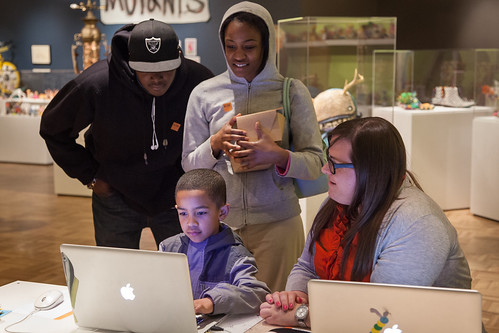
5: Minecraft
Minecraft makes its own gravy. Just having Minecraft playable was a big draw for kids. But this "What Went Right" goes beyond that. Really, it touches on a fundamental truth about software. That truth is: you can immediately tell when you're handling good software.
What does that mean? It means that I was able to stand up a Minecraft server running our custom map and run 5 clients against it without ever having done so before. I'd never run a Minecraft server. I kind of feel as though I still haven't, even though we ran this server for three days during the exhibit.
Why don't I feel like I ran a server? Because it's too flipping easy. The Minecraft server jar just works, and the commands to fiddle with it are simple and direct. It is very obvious that Notch and Jens have polished the underlying code to a glistening shine, at this point.
Minecraft is just a dream to work with. It's easy, does what it's supposed to, and caused no problems during this exhibit. Later, we would have some issues due to lack of Internet at Maker Faire, but that was the fault of that expo, not Minecraft.
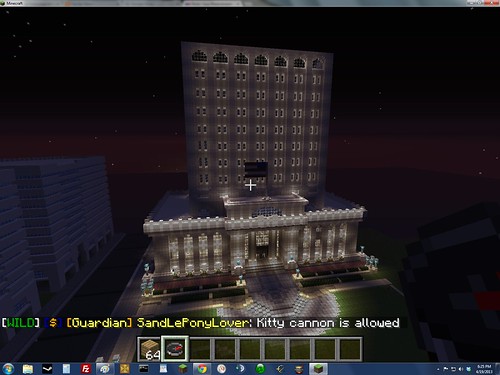
What Went Wrong
1: Advertising
With such short notice, we really didn't get enough time to go and promote this collaboration. While attendence was high at the exhibit, I felt we could have more significantly impacted those numbers through some more directed marketing.
As it stands, all we really did to promote the event was put out a press release. While it was picked up in a few places, some other outlets immediately dropped plans on larger pieces once the actual release had made the rounds. The gaming press has, as ever, fairly short attention spans.
2: Maker Faire
After the Oakland Museum exhibit, we had planned on bringing the Oakland map to Maker Faire and recreating the experience. Unfortunately, Maker Faire has some terrible Internets. Minecraft's central-server validation requires the Internet to make the clients work. While there is an offline mode that can be accessed without validating online, it seems the server automatically rejects any unvalidated clients.
I'm told this can be turned off in the server configuration, and we had a local server expert do just that. However, this didn't seem to solve the problem.
As a result, none of our Maker Faire client machines could log into the central server with the Oakland map. As a last-minute compromise, we set all the clients into single-player mode. This in no way effected the enthusiasm of the kids who visited our booth, and no one who came by asked "where's Oakland?"
Still, I wish we could have had a single map for the kids to work on together. Instead, all the kids at our Maker Faire booth generated their own world and played alone. At the end of that weekend, we had about 50 individual worlds per machine.
Kids had to be physically dragged away from our booth by their parents, who were irked they'd paid $30 a head for their kids to come to Maker Faire and play a game they have at home.
3: Dynamite
"It's not dynamite, it's TNT," said one little boy in the Oakland map, while I explained to him that what he was doing wasn't exactly in the spirit of the exhibit.
But it didn't matter. We'd set the server into creative mode, which meant all players could spawn any item they wanted into their inventory. With so many little boys running around in the exhibit space, it was a safe bet that TNT would be a popular item.
And it was. As you can see in the before and after maps linked to at the top of this article, 90% of the changes made to the Oakland map were dynamite-related. Those that weren't dynamite fans tended to spawn infinite creepers or ghasts into the city. It was a real mess.
For this reason, we started with a fresh copy of Oakland every morning.
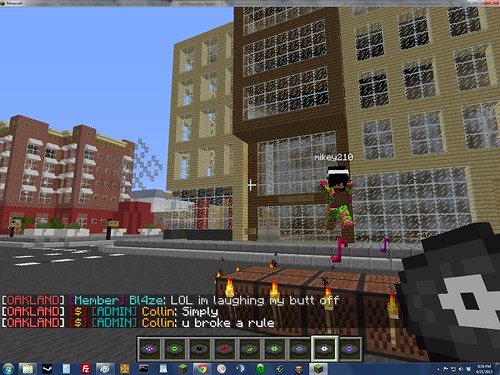
4: Time Constraints
While the time constraints were also a positive thing, I feel that more of Oakland could have been built by the Paradise team if they'd had more time. As things worked out, they crunched hard and managed to build a lot of the downtown area, but their initial estimates of how much they'd get done were way off.
This, combined with a server move shortly after the exhibit closed kept the Paradise community from continuing work on Oakland after the show ended. When the server moved to a new IP, a new version of Minecraft was also released, and it broke a lot of their existing architecture, outside of Oakland.
As a result, Paradise was basically rebuilding itself as soon as the OMCA exhibit closed its doors. And thus ended the building of Oakland.
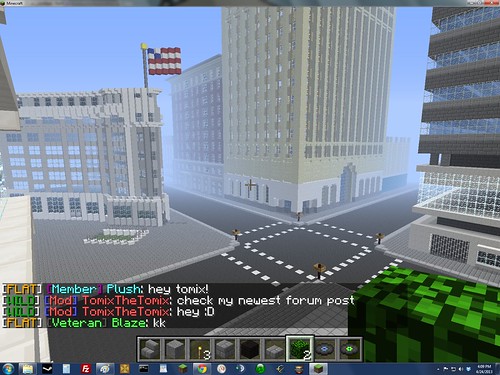
5: Google Maps
This isn't a major problem, but it did raise an issue that concerns me about the upcoming generation.
In order to build Minecraft Oakland, the builders on the Paradise server used Google Street View as a reference. They'd see what a building was called in Google Maps, and consider that the end-all of the subject. Google, in the minds of these kids building Oakland (not in the minds of the adults helping) was always right.
That building at 14th and Broadway? That's the police station because Google Street View says so. It's not, really. Hasn't been in about 15 years. But Google says so, so it must be.
This is a worrisome trend for all of society, not just for this project.
Read more about:
Featured BlogsYou May Also Like